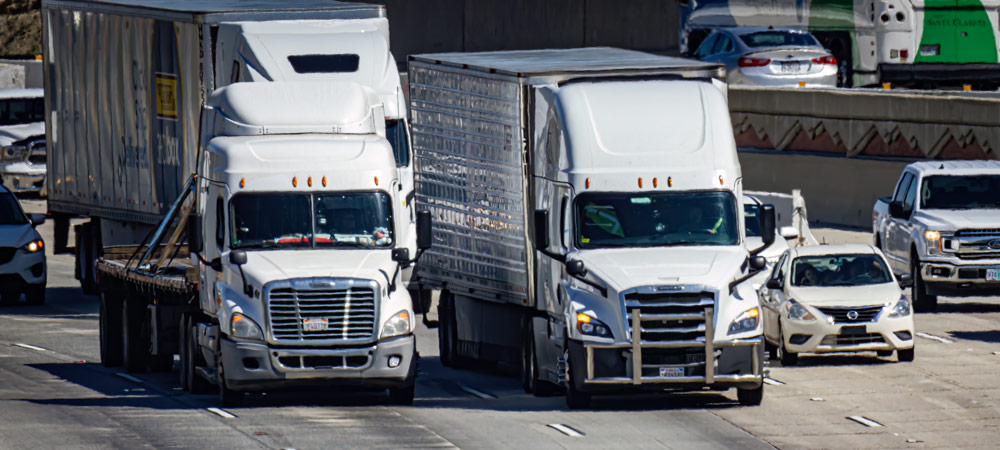
The increasing number of trucks on our roads has contributed to a growing number of truck accidents. Whether drivers are rushing to beat deadlines or they’re driving under the influence, their actions have the potential to cause severe accidents.
Analyzing truck accident facts will equip you with provide knowledge of what to do and what to avoid on the road.
Truck accident facts are also used in legal proceedings to determine who is liable for the accident, how much damage has been done, and how much compensation the victims will get. In short, facts help to build a stronger legal case.
Lastly, analyzing accident facts is crucial to relevant authorities as they rely on them to come up with effective measures to increase safety for everyone on the road.
Through these facts, you’ll have an understanding of the:
- Factors contributing to truck accidents in the USA
- Types of trucks most likely to be involved in accidents
- Types of accidents mostly associated with trucks
- Places truck accidents occur, and the days and time of the event
- Measures that authorities have put in place to minimize the risk and number of truck crashes
If, unfortunately, you get involved in a truck accident, our attorneys at Vegas Valley Injury Law will see to it that you’re appropriately compensated for the physical, emotional, and financial damages.
Had a vehicle accident and needed help. I went to Vegas Valley Injury Law were the staff was pleasant and knowledgeable, and they kept me up to date. Thanks for having my back.”
— Erik Dills, USA
Breaking Down Truck Accident Facts You Need to Know

- Large trucks are any medium or heavy trucks (excluding buses and motorhomes but including commercial and non-commercial trucks) with a gross vehicle weight rating (GVWR) of more than 10,000 pounds.
- Large trucks weigh 20–30 times more than passenger vehicles. They have a greater ground clearance which smaller vehicles sometimes slide under with deadly consequences.
- Large truck crashes have a considerable impact on society and the economy due to medical costs, property damage costs, and loss of productivity.
- Truck crashes are generally more severe than other types of crashes.
- Trucks are more likely to be involved in fatal multiple-vehicle crashes than single-vehicle fatal crashes.
- Tractor trailers are the most dangerous trucks on the road when it comes to truck accident crashes.
- Not everyone involved in a truck accident is a driver or passenger in another motor vehicle. Some of the victims are pedestrians and cyclists.
- The states with the highest count of truck accidents are in the middle of the country compared to the eastern and western parts of the country.
- Cellular phone usage, failure to yield right of way, inattentiveness, and failure to obey traffic rules all increase the probability of fatal truck crashes.
- A truck with an out-of-adjustment brake system is 1.8 times more likely to be the cause of the crash.
- Although efforts have been made to understand crashes involving large trucks, the relationship between crash-related factors, crash severity, and time of day is still not completely understood.
- The majority of crashes and non-fatal crashes involving large trucks occur between Monday and Friday.
- Unsafe actions of automobile drivers are a contributing factor in the majority of fatal crashes involving trucks.
- In half of two-vehicle crashes involving a large truck and another vehicle, both vehicles were proceeding straight at the time of the crash.
- Anti-lock brakes, which keep wheels from locking after braking hard, improve a driver’s control of the truck during emergency brakes, thereby reducing the likelihood of a tractor-trailer from jackknifing.
- Impaired driving (under the influence of alcohol or drugs) is the most common cause of crashes that lead to injury and death in Nevada.
- Nevada’s laws state that a blood alcohol concentration (BAC) of 0.8% is illegal. However, even a concentration as low as 0.02% can impair a truck driver, making them incapable of concentrating on the road.
- Stopping distances for trucks are much longer, particularly on wet and slippery ground or if the brake system is poorly maintained.
- On average, drivers of large trucks travel more miles than drivers of passenger vehicles. A huge portion of these miles is on interstates, which are the safest roads.
- Newer trucks encounter higher rates of fires and fatal fires per vehicle compared to trucks five years or older.
- In 2021, more than half of fatal truck crashes occurred on rural roads and almost a quarter happened on interstates.
- Class 6 and class 8 trucks have the highest rates of fire per billion vehicle miles traveled, while class 4 and 5 trucks have the lowest rates of fire.
- To minimize the risk of colliding with a truck, passenger vehicle drivers should avoid a truck’s blind spots and be aware that trucks have long stopping distances and also make wide turns.
- Electronic stability control (ESC) is a crash avoidance technology for all new tractors since August 2019. It’s designed to intervene when a truck’s motion becomes unstable, which has the probability of resulting in rollovers or jackknifing.
- When trucks are involved in rollover or jackknife accidents, they exponentially increase the severity of the crash.
- Drivers of large trucks are less likely to have a previous license suspension or revocation than passenger vehicle drivers.
- Likelihood ratios indicate that factors such as a stopped or an unattended vehicle have a greater probability of being involved in truck crashes than in non-truck crashes.
- Truck drivers who are behind the wheel for more than eight hours are twice as likely to crash due to sleep deprivation.
- In Nevada, a large number of truck accident fatalities are unrestrained compared to car fatalities.
- In a study of truck crashes, the first major cause was failing to adjust to speed curves on the road, the second was inattention, and the third was oversteering to the point of rolling over.
- Younger truck drivers are more likely to be involved in fires than older truck drivers, whereas older drivers are more likely to be involved in fatal truck fires.
- Despite their low numbers, truck accidents involving fire are a greater risk on highways than accidents without fires.
- In 2020, speeding of any kind was the most common driver-related cause of accidents for drivers of both vehicles. Fatigue and alcohol was the second most common.
- In 2020, large trucks were more likely to be involved in fatal multi-vehicle collisions as opposed to single-vehicle crashes.
- Tractor trailers with defective equipment were twice as likely to be involved in crashes than trucks without defects.
- Tractor trailers are vulnerable to rollovers because of the trailer’s high center of gravity and frequently unstable loads.
- Over four-fifths of truck crashes occurring on curves are attributed to misjudgement by the driver.
- The rate of passenger vehicle occupants killed per truck mile traveled, and the rate of large truck occupants who died per truck mile have declined since 1975.
- The rate of fatal commercial truck fires is almost four times the percentage of commercial trucks registered.
- The large size of trucks makes them difficult to maneuver smoothly on roadways. The element of blind spots is also challenging to the truck driver and surrounding vehicles when it comes to avoiding the risk of a crash.
- In 2008, large trucks were 3.2 times more likely than other vehicles to be struck in the rear in a two-vehicle fatal collision.
- In 2014, general freight trucking had an injury and illness rate double that of all other private sector industries, and injuries requiring days from work were three times higher than all other private sector industries.
- The average cost of no-injury crashes, non-fatal injury crashes, and fatal crashes involving large trucks are $15, $114, $195,258, and $3,604,518 respectively.
- The trucking industry is committed to improving safety and each year it invests at least $10 billion in safety technology and driver safety incentive pay.
- Half of large truck crashes in Large Truck Crash Causation Studies (LTCCS) usually involve a large truck and a passenger vehicle, such as a van, a car, or a utility vehicle.
- A critical pre-crash event is the action or event that placed a truck on a collision course that was unavoidable despite the driver’s skills and vehicle handling.
- The adverse effects of single unit truck crashes have been underestimated in the past because these trucks are frequently misclassified, and thus undercounted in federal and state databases.
- A truck underride crash occurs when a car slides under a large truck, such as a tractor trailer, crushing the car and injuring or killing the occupants.
- Loaded tractor trailers need more space to stop than passenger vehicles, which means the driver has very little time to react in case he needs to brake suddenly.
- Most fatal truck crashes occur on weekdays during the daytime, while the deadliest month for truck crashes in 2018 was October.
The above truck accident facts provide crucial insights into the complex interplay of factors contributing to these incidents.
As the nation experiences fluctuations in road fatalities and injuries from accidents, it’s crucial to keep monitoring these traffic trends and adjust strategies accordingly.
What Are Authorities Doing Concerning Truck Safety?

From imposing penalties to regulating service hours for truck drivers, U.S. authorities are doing all they can to improve the situation.
There are two departments that oversee large truck safety. One is the National Highway Traffic Safety Administration (NHTSA), which is responsible for setting the standards for new truck equipment.
The other department is the Federal Motor Carrier Safety Administration (FMCSA), which oversees the safety of commercial vehicles and has jurisdiction over equipment, licensing, hours of service, maintenance, and inspections.
Here’s what these two departments and other related authorities are up to:
- The National Safety Council offers a Professional Truck Driver Training online course, which gives truck drivers information on how to maneuver out of tricky situations and avoid truck-related incidents.
- The Federal Motor Carrier Safety Administration (FMCSA) established regulations for hours of service to prevent accidents caused by trucker fatigue.
- Nevada authorities are addressing pedestrian safety through educational campaigns. These campaigns teach about the importance of using crosswalks, obeying traffic signals, and remaining visible to truckers and other drivers at night.
- NHTSA issued the final rear impact guard rule to improve protection for drivers and passengers of smaller vehicles in case of an underride accident (when the front of a small vehicle crushes and slides under the back of a truck).
- The Nevada Department of Transportation (NDOT) gathered feedback that ended the State 160 and 159 Corridor Study to identify future enhancements that can be made on the corridor and its surroundings.
- Violating trucking laws on Nevada roads leads to fines and penalties depending on the severity of the violation, and they’re subject to double if the violation happens in a work zone.
- In 2017, NDOT completed a $16.5 million project to widen State Route 160 in Nevada at the section between Red Rock Canyon and Mile Marker 17 onward. The highway was expanded to four lanes, and an additional passing lane added in each direction.
- Under federal hours-of-service regulations, drivers of large trucks are allowed to be behind wheels for only 11 hours a stretch to avoid fatigue-related accidents.
- In 2020, FMCSA proposed a pilot program that subjected truck drivers under 21 to a supervised driving period and crash-avoidance technologies to prevent road accidents, since younger drivers are more likely to get involved in accidents.
- A Large Truck Crash Causation Study (LTTCS) was carried out by FMCSA on 239 truck crashes. Data of up to 1,000 factors in the crashes were collected to analyze the cause of large truck rollovers.
Did You Know? Negligence plays a significant role in truck accidents. Factors such as distracted driving, failure to adjust to speed curves, and oversteering contribute to the majority of truck crashes.
Exercise Your Legal Rights to Get Compensation After a Truck Accident
You have the right to seek compensation for injuries, medical expenses, loss of wages, suffering, and other losses.
You can gather evidence such as photographs, medical reports, and witness statements to support your claim.
And you also have the right to be represented by an attorney who will help you navigate the whole truck accident legal process.
Vegas Valley Injury Law is the trusted team for the job.
We are local attorneys aggressively representing Las Vegas truck accident victims to help them get the compensation they deserve.
What do we bring to the table? Personal service where one lawyer oversees your case from start to finish.
Highly recommend coming down to Vegas Valley Injury Law, took care of me and were extremely professional with their work. They will not disappoint.”
— Cobi Villalba, USA
Our team has decades of experience and is accessible 24/7.
The best part is that you won’t have to pay us a dime until you win.
If you or someone you know has been involved in a truck accident, get in touch with us at (702) 444-5555 for a free consultation.
Learn more about what truck accident attorneys do in the video below.